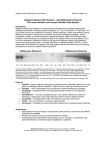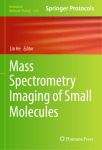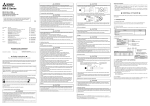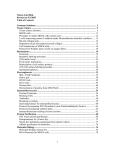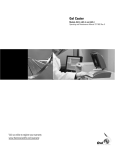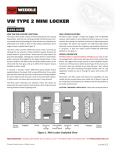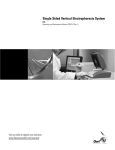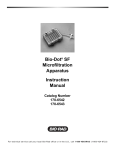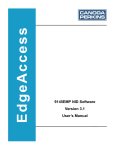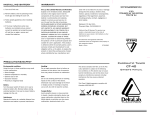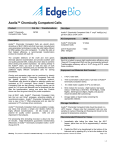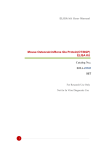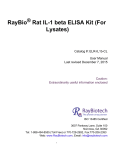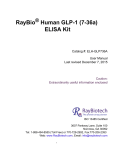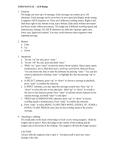Download Details... - protein expression services
Transcript
Attoglow Western Blot System User Manual Attoglow Western Blot System - with Millennium Enhancer The most sensitive non-isotope Western blot System Introduction Attoglow Western Blot System is an ultra-sensitive chemiluminescent Western blot System developed by CytoMol. It detects protein at attogram (10-18 g) or yoctomole (10-24 M) levels. This kit consists of three parts: Millennium Enhancer, protein interaction system and detection system. Millennium Enhancer is derived from a powerful, innovative proprietary technology. Unlike conjugated complex- or chemiluminescent substrate-enhancers, Millennium Enhancer works through a novel mechanism by increasing antigen and antibody affinity and accessibility. Due to its unique mechanism, Millennium Enhancer can work with different antigens and antibodies, such as structural proteins (Actin), enzymes (GAPDH) or membrane proteins (EGFR). It could significantly boost Western blot signals, and work together with the two other kinds of enhancing mechanisms to achieve multiplied enhancing effects. - Millennium Enhancer 1ng 0.1ng 10pg 1pg 0.5pg 0.1pg 10fg + Millennium Enhancer 10ag 1ag 1ag 10ag 10fg 0.1pg 0.5pg 1 pg 10pg 0.1ng 1 ng One ng of purified Rabbit muscle GAPDH was serially diluted to 1 attogram and electrophoresis was performed. The gel was transferred to a PVDF membrane, and then cut in the middle. The right section was treated with Millennium Enhancer, and the left was untreated. Immunoblotting was done using a primary antibody (clone 6C5) and HRPconjugated rabbit anti-mouse antibody, and chemiluminescent substrates were applied. A film exposed for two minutes is -11 -14 shown above. 10 g of antigen without treatment and 10 g of GAPDH with treatment gave similar signal strengths, indicating a 1000-fold enhancement*. * Fold enhancement varied from a few- to a 1000-fold depending on the characteristics of antibodies and antigen used. Features • Sensitive - detect antigens at atto gram or yoctomole level, extremely useful for low copy genes or antibodies with low sensitivity. Others’ kits only reach up to femto gram level. • Versatile – 100% Enhancement on top of all kinds of chemiluminescent substrates • Synergistic - Synergistic effect with conjugated complex enhancers and substrate enhancers • Cost Effective – The most competitive price on the market, sufficient for 2,500 cm² membrane. Listed price is 20% lower than that of other vendors’ Western blot kits • Compatible - Compatible with PVDF, nitrocellulose, and nylon membranes • Simple - Very user-friendly, non-isotope, equipment free • Convenient - Complete kit contains secondary antibody and chemiluminescent substrate Applications • Detects trace amount of antigen, low expression gene products, useful when poor affinity antibodies are available. • Western and protein arrays where high sensitivity is needed. • Combinations with other Western blot enhancers; for an example, in combination with substrate enhancers, enhanced signal magnification is achieved. Cytomol Unimed 592-10 Weddle Dr., Sunnyvale, CA 94089 USA Tel: 408-992-0400 Fax: 877-713-8298 E-mail: [email protected] Website: www.cytomol.com 1 Attoglow Western Blot System User Manual Description Components in this kit are prepared with pure chemicals according to our proprietary technology. They are used for ultra-sensitive chemiluminescent analysis with Western blotting applications. This kit provides a complete system for Western blot analysis, including a 1) powerful, novel proprietary technology, Millennium Enhancer, which could significantly boost Western blot signals, 2) protein interaction system and 3) chemiluminescent detection system. The protein interaction system has been optimized to be compatible with Millennium Enhancer to achieve a superior result. Four different formats are provided according to the type of secondary antibody that is supplied (HRP-conjugated anti Mouse /anti-Rabbit /anti-Chicken /anti-Goat IgG). Two different sizes are available: 1,200 cm2 and 2,500 cm2 of membrane. Enhancing activity is confirmed in Western blot analysis of GAPDH protein with the corresponding antibody. Quality Control Duplicated Western blots containing 10 fg and 10 pg of antigen are detected with anti-GAPDH antibody. Antigen at 10 fg levels was detected only on the blot treated with Enhancer, with similar intensity as antigen at 10 pg level on the untreated blot. Components Attoglow Western Blot System Catalog Number: pkd7112x(1-4) Item 1. Millennium Enhancer 2. Antibody Binding Buffer (20 x) 3. Attoglow Blocking Agent 4. HRP Conjugated Secondary Antibody (anti-Mouse or anti-Rabbit or anti-Chicken or anti-Goat) 5. Luminescence substrate solution A 6. Luminescence substrate solution B Reagents are sufficient for 1,200 cm² membranes Catalog Number: pkd7125x(1-4) Item 1. Millennium Enhancer 2. Antibody Binding Buffer (20 x) 3. Attoglow Blocking Agent 4. HRP Conjugated Secondary Antibody (anti-Mouse or anti-Rabbit or anti-Chicken or anti-Goat) 5. Luminescence substrate solution A 6. Luminescence substrate solution B Reagents are sufficient for 2,500 cm² membranes Amount 50 ml 60 ml 20 g 55-110 µl Part No. pkd7112x-1 pkd7112x-2 pkd7112x-3 pkd7112x-4 25 ml 25 ml pkd7112x-5 pkd7112x-6 Amount 100 ml 120 ml 40 g 110-220 µl Part No. pkd7125x-1 pkd7125x-1-2 pkd7125x-1-3 pkd7125x-1-4 50 ml 50 ml pkd7125x-1-5 pkd7125x-1-6 Attoglow Western Enhancing Kit Item 1. Millennium Enhancer 2. Antibody Binding Buffer (20 x) 3. Attoglow Blocking Agent Amount (wka72120) 50 ml 60 ml 20 g Part No. wka72120-1 wka72120-2 wka72120-3 Amount (wka72250) 100 ml 120 ml 40 g Reagents are sufficient for 1,200 or 2,500 cm² membrane Part No. wka72250-1 wka72250-2 wka72250-3 Items not supplied in Enhancing Kit: 1. Primary antibody. 2. Secondary antibody. 3. Chemiluminescent Substrates 4. Wash buffer (1 x TTBS). 5. Membrane stripping and re-probing buffer. Storage and Stability Solutions 1, 2, and 3 can be stored at room temperature. Solutions 4, 5 and 6 should be stored at 2-8°C. The kit is stable for one year when handled properly. Cytomol Unimed 592-10 Weddle Dr., Sunnyvale, CA 94089 USA Tel: 408-992-0400 Fax: 877-713-8298 E-mail: [email protected] Website: www.cytomol.com 2 Attoglow Western Blot System User Manual Protocol 1. Remove blot from the transfer apparatus and soak in transfer buffer. Under the hood, pour the Millennium Enhancer solution into a new container. For a 50 cm2 blotting membrane, use 10 ml Millennium Enhancer, and the solution can be re-used 4 times without losing its enhancing effect. Pick the membrane from the transfer buffer and drain the remaining buffer on the membrane. For best results, do not let the membrane dry completely. Soak the membrane in the Millennium Enhancer solution, agitate for 2 min, then remove the membrane and submerge it in 1 x TTBS solution. 2. Block the membrane with 5% non-fat dry milk in 1 x TTBS solution for 30 min at room temperature with agitation. 3. Prepare antibody binding working buffer by diluting the supplied 20x antibody binding stocking buffer 20 times with ddH2O. Make an appropriate dilution of primary antibody in antibody binding working buffer; 10 ml of primary antibody solution volume is suggested for a 50-cm2 membrane. Remove the blocking reagent and add the primary antibody solution. Incubate the blot with agitation for one hour at room temperature to overnight at 2-8°C. 4. Wash the membrane in 1 x TTBS for 5 min, repeat 3-4 times. 5. Incubate blot with the appropriate HRP-conjugate secondary antibody solution, diluted with antibody binding working buffer (e.g., 1:5,000 for anti-Mouse IgG) for 1 hour at RT with agitation. Ten ml secondary antibody solution is suggested for membrane size of 50 cm2. 6. Repeat step 4 to remove unbound HRP-conjugate. 7. Prepare substrate-working solution by mixing equal volume of Substrate Buffer A and Buffer B right before developing, 2 ml substrate working solution (mixture of 1 ml Buffer A and 1 ml Buffer B) is suggested for a 50 cm2 membrane. 8. Incubate blot with substrate working solution for 1-5 min. 9. Place membrane between plastic protection sheets or transparent plastic wrap, and mount inside a film cassette with the protein side facing up. 10. Place a piece of film on top of the membrane, let it expose for an appropriate time, and develop the film. A recommended initial exposure time is 1 min. 11. The blot can be re-developed if necessary. 12. After stripping, the blot can be re-probed. Re-developing Method Soak membrane in 1 x TTBS solution at 2-8°C O/N. On the second day, (incubate with secondary antibody and apply wash buffer, this step is optional) add substrate and expose on film. Stripping Method Use stripping buffer M if the mild condition is sufficient; and use stripping buffer H if more stringent stripping conditions are necessary. 1. Soak the membrane in stripping buffer and incubate at 50°C for 30 min with occasional agitation (incubate for a longer time or raise temperature to 70°C if the membrane is not completely stripped). 2. Wash the membrane twice in a large volume of 1 x TTBS for 10 min at room temperature. 3. Repeat the immunoblotting procedure from the blocking step. Trouble Shooting 1. General Problems 1.1 No signal or weak signal • Proteins did not transfer properly to membrane Cytomol Unimed 592-10 Weddle Dr., Sunnyvale, CA 94089 USA Tel: 408-992-0400 Fax: 877-713-8298 E-mail: [email protected] Website: www.cytomol.com 3 Attoglow Western Blot System User Manual • Not enough protein loaded on the gel • Target protein degradation occurred due to improper storage of blot • The concentration of primary or secondary antibody used was too low • The blocking buffer used was not correct, and antigen was covered • Substrate had lost activity 1.2 High background • The concentration of the primary or secondary antibody used was too high • Too much protein loaded on the gel • Insufficient blocking • Insufficient washing • The level of Tween-20 in blocking buffer was too low • Membrane problems: e.g., PVDF membrane was not wetted thoroughly or dried in processing • Transfer buffer been contaminated 1.3 Reverse image on film • Too much antigen • Too much HRP in the system 2. Kit-specific Problems 2.1 Little or no Enhancing Effect • The antigen level was too high, the signal was already saturated • Too much buffer remained on the membrane before Millennium Enhancer treatment or Millennium Enhancer has been re-used too many times, Millennium Enhancer has been diluted too much and lost its activity • The membrane was not treated long enough in Millennium Enhancer solution • Specific nature of antigen 2.2 High Background • A general problem, see above • The signal was magnified too highly, use the kit without Millennium Enhancer treatment Related Products Western Blot, Protein array, Total protein, Compartment Proteins Appendix Preparation of solutions not supplied with kit: Solution 1 x TTBS Blocking Solution Stripping Buffer M Stripping Buffer H Preparation Add 6.05 g Tris base (50 mM), 8.76 g sodium chloride (150 mM) to 800 ml distilled water, adjust pH to 7.5 with HCl; adjusted to 1 liter with distilled water. Add Tween-20 to 0.1% (v/v) Weigh 5 g of non-fat dry milk and dissolve it in 100 ml 1 x TTBS solution 100 mM Glycine, pH 2.7 Stability/temperature 3 months at RT Notes Do not use sodium azide as an antimicrobial agent as it inhibit HRP Freshly made suggested 1 month at RT Can be Stored at 2-8°C O/N Mild stripping buffer 62.5 mM Tris-HCl, pH 6.7 with 2% SDS and 100 mM 2-Mercaptoethanol 1 month at RT Harsh stripping buffer Cytomol Unimed 592-10 Weddle Dr., Sunnyvale, CA 94089 USA Tel: 408-992-0400 Fax: 877-713-8298 E-mail: [email protected] Website: www.cytomol.com 4




